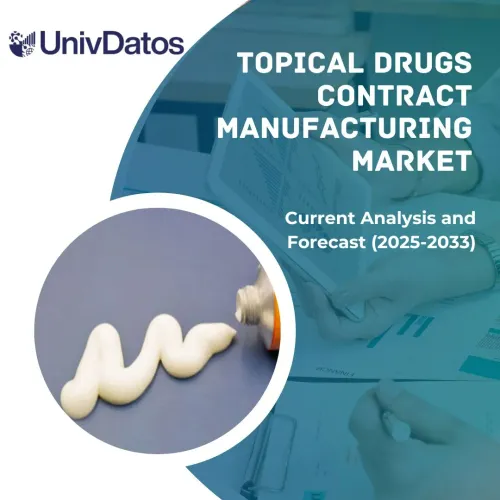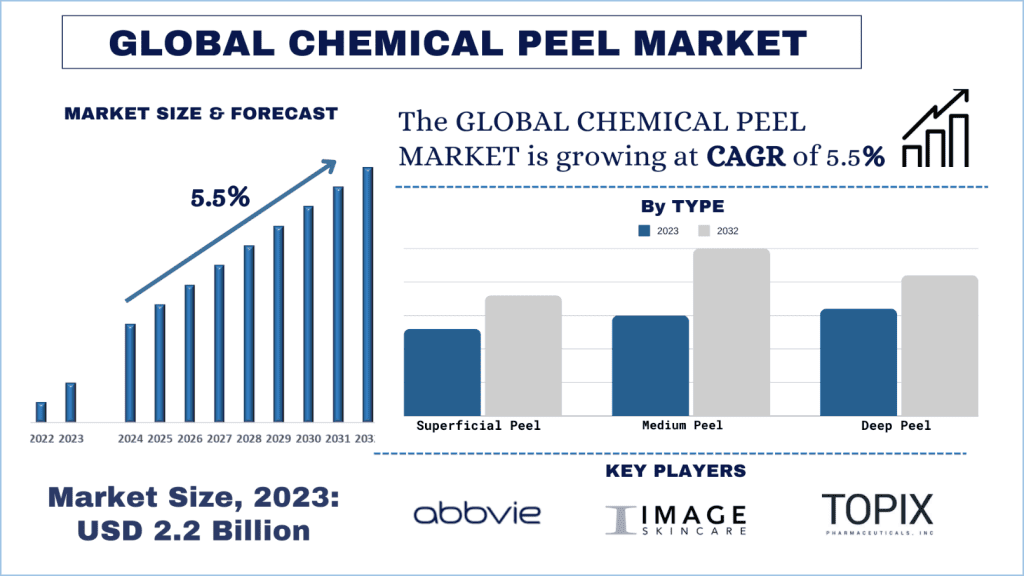
화학 박피 시장 규모 & 예측
화학 박피 시장은 약 USD 22억 달러로 평가되었으며, 미용 성형의 증가 추세에 힘입어 예측 기간(2024-2032) 동안 약 5.5%의 강력한 연평균 성장률(CAGR)을 보일 것으로 예상됩니다.
화학 박피 시장 분석
화학 박피 시장은 최근 몇 년 동안 스킨케어 및 미용 치료에 대한 인식 증가, 기술 발전, 그리고 노화 인구 증가로 인해 꾸준한 성장을 경험해 왔습니다. 시장은 표피 박피와 같이 처방전 없이 구입할 수 있는 제품부터 피부과 전문의 또는 스킨케어 전문가가 수행하는 보다 심도 있는 의료 등급 박피에 이르기까지 다양한 피부 유형 및 고민에 맞는 광범위한 화학 박피 제품을 포함합니다. 소득 증가, 생활 방식 변화, 소셜 미디어가 미용 트렌드에 미치는 영향과 같은 요인 또한 화학 박피 시장의 성장에 기여합니다. 또한, 여드름, 과색소 침착, 불균일한 피부톤, 노화 징후와 같은 고민에 대한 실질적인 해결책을 찾는 사람들이 늘어나면서 화학 박피에 대한 수요가 계속 증가하고 있습니다. 시장은 사람들이 미용 및 자기 관리를 점점 더 중요하게 생각함에 따라 계속 확장될 것으로 예상됩니다.
예를 들어, 미국 성형외과 학회에 따르면, 화학 박피, 피부 연마술, 레이저 펄스 요법, 피부 재포장술과 같은 피부 회춘 치료가 계속해서 인기를 얻고 있습니다.
또한,또한, 미국의 미국 성형외과 학회에 따르면, 2022년에 총 3,322,292건의 피부 재포장술 치료가 시행되었으며, 화학 박피술도 포함되었습니다.
또한, 주요 업체 중 베이비붐 세대가 2022년 피부 재포장술 시장에서 상당한 점유율(61%)을 차지했으며, 여기에는 피부 연마술, 화학 박피술, 다양한 레이저 치료가 포함됩니다.
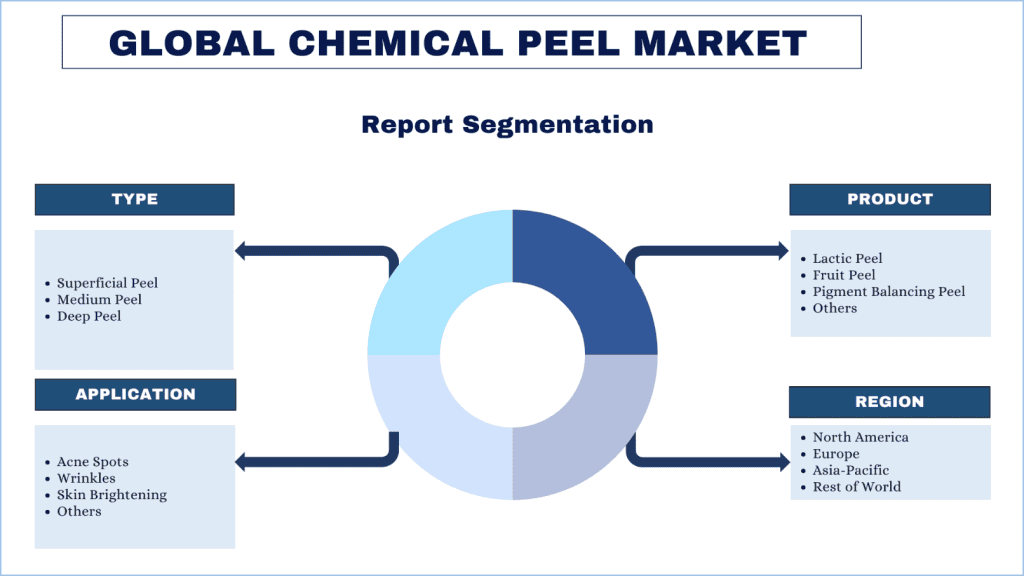
화학 박피 시장 동향
이 섹션에서는 연구 전문가 팀이 파악한 화학 박피 시장의 다양한 세그먼트에 영향을 미치는 주요 시장 동향에 대해 설명합니다.
피부 미백 세그먼트, 산업 변화 주도
화학 박피 시장의 피부 미백 세그먼트는 여러 요인에 의해 수년 동안 꾸준한 성장을 보였습니다. 과색소 침착, 흑점, 불균일한 피부톤을 개선할 수 있는 스킨케어 제품 및 치료에 대한 수요가 증가하고 있습니다. 피부 미백 화학 박피는 피부를 각질 제거하고 색소 침착 불규칙성을 줄여 효과적인 솔루션을 제공합니다. 이러한 치료법은 햇빛 손상을 최소화하려는 흰 피부를 가진 사람들과 염증 후 과색소 침착의 위험 없이 과색소 침착 문제를 해결하려는 어두운 피부톤을 가진 사람들을 포함하여 다양한 소비자에게 어필합니다. 스킨케어 회사는 알파 하이드록시산(AHAs), 베타 하이드록시산(BHAs), 코직산, 비타민 C, 니아신아미드와 같은 성분을 포함하여 피부 미백 화학 박피를 위한 고급 제형을 개발했습니다. 이러한 성분은 피부 각질을 제거하고 멜라닌 생성을 억제하며 더 밝은 피부톤을 촉진하기 위해 시너지 효과를 발휘합니다. 화학 박피 시장의 피부 미백 세그먼트의 성장은 소비자 인식, 기술 발전, 안전하고 접근 가능한 치료법의 가용성에 의해 주도되는, 더 빛나고 균일한 피부톤을 얻기 위한 효과적인 솔루션에 대한 증가하는 수요를 반영합니다.예를 들어, 2023년 10월, 스킨브라이트-하이드라 페이셜 및 마이크로 필 트리트먼트와 같은 제품으로 유명한 세계적인 의료 미용 스킨케어 브랜드인 SkinCeuticals는 미국에서 NOVA Plastic Surgery가 운영하는 SkinCeuticals SkinLab Ashburn의 개장을 발표했습니다.
북미, 예측 기간 동안 상당한 CAGR 성장 예상
북미 지역 내에서 미국이 시장의 주요 점유율을 차지하고 있습니다. 이 국가에서 시장 성장을 촉진하는 주요 요인은 지역의 빠른 도시화, 기술 발전의 증가, 피부 재포장술의 증가 추세, 저렴한 시술, 혁신적인 유형 출시, 그리고 여러 시장 참여자의 존재입니다.
국제 미용 성형 학회에 따르면, 2022년 멕시코에서 14,265건의 화학 박피술이 시행되었고, 미국에서 371,228건이 시행되었습니다.
2023년 1월, 미국 기반의 Derma E는 새로운 비타민 C 10% 멀티-산성 래디언스 리퀴드 필 & 레티놀 컨센트레이티드 세럼을 출시했습니다.
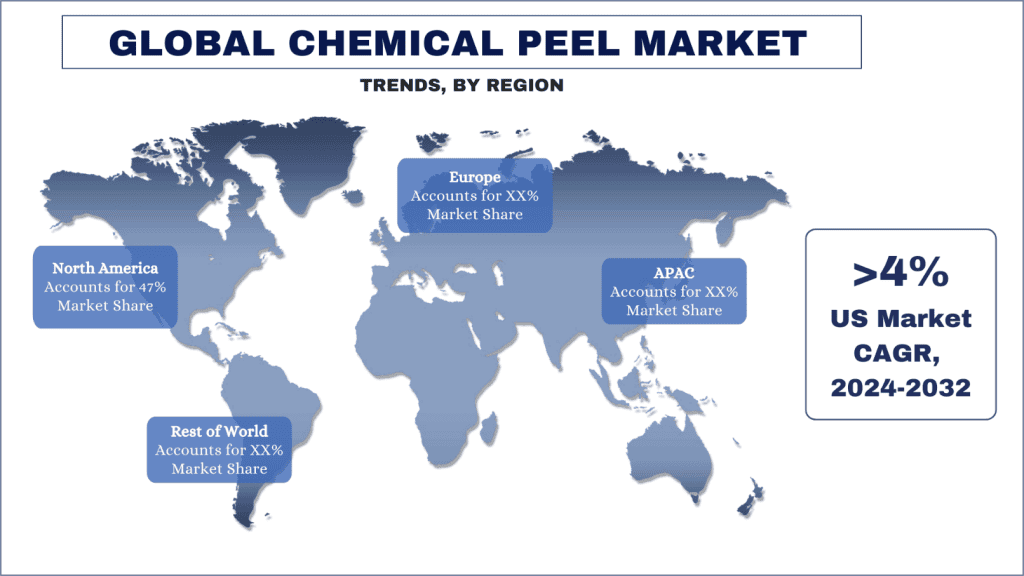
화학 박피 산업 개요
화학 박피 시장은 여러 글로벌 및 국제 시장 참여자의 존재로 경쟁이 치열합니다. 주요 업체들은 파트너십, 계약, 협력, 신규 유형 출시, 지리적 확장, 인수 합병과 같은 다양한 성장 전략을 채택하여 시장 입지를 강화하고 있습니다. 시장에서 활동하는 주요 업체로는 Image International Manufacturing, LLC, Dermalogica, Renée Rouleau Inc., L’Oréal Paris, Lasermed, AbbVie, Glytone, Galderma, Teoxane, Topix Pharmaceuticals, Inc. 등이 있습니다.
화학 박피 시장 뉴스
- 2024년 3월,Advanced Grohair & Gloskin Clinic은 인도에 2번째 센터를 개설했습니다. 이 클리닉은 글루타티온, 하이드라 페이셜, 화학 박피, 보톡스, 필러 등 다양한 훌륭한 피부 치료법을 제공합니다.
- 2023년 2월,영국 기반의 BEAUTYLAB은 화학 박피와 그 효능을 소개하기 위해 고급 화학 박피 웨비나를 출시했습니다.
- 에2022년 1월,미국 기반의 Vitality Institute는 유명한 스킨케어 브랜드로, 흉터와 반복적인 발진을 줄이기 위해 몸의 여드름을 표적으로 삼고, 수술이나 부상으로 인한 흉터를 부드럽게 하고, 튼살의 외관을 개선하며, 처진 피부를 조여주는, 최초의 VI Peel Body Treatment를 출시한다고 발표했습니다.
화학 박피 시장 보고서 범위
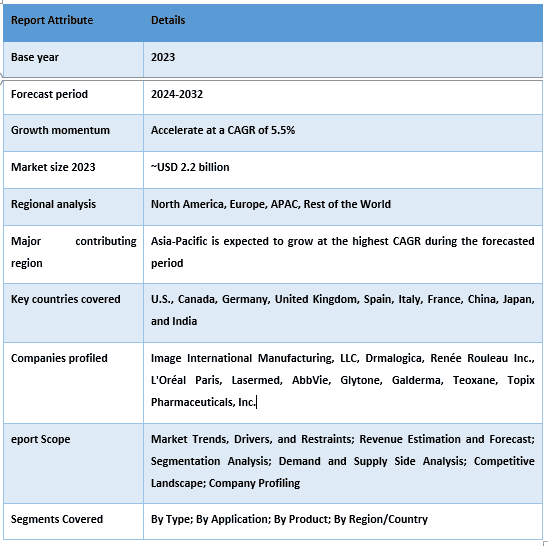
이 보고서를 구매해야 하는 이유:
- 이 연구에는 인증된 주요 업계 전문가가 검증한 시장 규모 측정 및 예측 분석이 포함됩니다.
- 이 보고서는 전반적인 산업 성과를 한눈에 빠르게 검토하여 보여줍니다.
- 이 보고서는 주요 비즈니스 재무, 유형 포트폴리오, 확장 전략 및 최근 개발에 중점을 두고 주요 업계 동료에 대한 심층 분석을 다룹니다.
- 업계에서 우세한 동인, 제약, 주요 트렌드 및 기회에 대한 자세한 검토.
- 이 연구는 다양한 세그먼트에 걸쳐 시장을 포괄적으로 다룹니다.
- 산업에 대한 심층적인 지역 수준 분석.
맞춤화 옵션:
글로벌 화학 박피 시장은 요구 사항 또는 기타 시장 세그먼트에 따라 추가로 맞춤화될 수 있습니다. 이 외에도 UMI는 귀사의 고유한 비즈니스 요구 사항을 이해하고 있으므로, 귀사의 요구 사항에 완벽하게 맞는 보고서를 받으려면 언제든지 문의하십시오.
목차
화학 박피 시장 분석을 위한 연구 방법론 (2024-2032)
과거 시장 분석, 현재 시장 추정, 글로벌 화학 박피 시장의 미래 시장 예측은 전 세계 주요 지역에서 화학 박피 채택을 만들고 분석하기 위해 수행된 세 가지 주요 단계였습니다. 과거 시장 수치를 수집하고 현재 시장 규모를 추정하기 위해 광범위한 2차 연구가 수행되었습니다. 둘째, 이러한 통찰력을 검증하기 위해 수많은 결과와 가정이 고려되었습니다. 또한, 글로벌 화학 박피 시장의 가치 사슬 전반에 걸쳐 업계 전문가들과 광범위한 1차 인터뷰가 진행되었습니다. 1차 인터뷰를 통해 시장 규모에 대한 가정과 검증을 마친 후, 전체 시장 규모를 예측하기 위해 톱다운/바텀업 방식을 사용했습니다. 그 후, 시장 세분화 및 데이터 삼각 측량 방법을 채택하여 업계의 세그먼트 및 하위 세그먼트의 시장 규모를 추정하고 분석했습니다. 자세한 방법론은 아래에 설명되어 있습니다:
과거 시장 규모 분석
단계 1: 2차 자료 심층 연구:
과거 화학적 박피 시장 규모를 회사 내부 소스(예:연간 보고서 및 재무제표, 성과 발표, 보도 자료 등)를 통해 얻기 위해 상세한 2차 연구가 수행되었습니다.및 다음을 포함한 외부 소스:저널, 뉴스 및 기사, 정부 간행물, 경쟁사 간행물, 부문 보고서, 제3자 데이터베이스 및 기타 신뢰할 수 있는 간행물.
단계 2: 시장 세분화:
과거 화학적 박피 시장 규모를 얻은 후, 주요 지역의 다양한 세그먼트 및 하위 세그먼트에 대한 과거 시장 통찰력과 점유율을 수집하기 위해 상세한 2차 분석을 수행했습니다. 주요 세그먼트는 유형, 적용, 제품 및 지역으로 보고서에 포함됩니다. 해당 지역의 테스트 모델 전반의 채택을 평가하기 위해 추가적인 국가별 분석이 수행되었습니다.
단계 3: 요인 분석:
다양한 세그먼트 및 하위 세그먼트의 과거 시장 규모를 획득한 후, 상세한요인 분석을 수행하여 화학적 박피 시장의 현재 시장 규모를 추정했습니다. 또한 화학적 박피 시장의 유형, 적용, 제품 및 지역과 같은 종속 및 독립 변수를 사용하여 요인 분석을 수행했습니다. 전 세계 화학적 박피 시장 부문의 주요 파트너십, 인수 합병, 사업 확장 및 유형 출시에 대한 수요 및 공급 측면 시나리오에 대한 철저한 분석이 수행되었습니다.
현재 시장 규모 추정 및 예측
현재 시장 규모 산정:위의 3단계에서 얻은 실행 가능한 통찰력을 바탕으로, 현재 시장 규모, 글로벌 화학적 박피 시장의 주요 업체 및 세그먼트별 시장 점유율에 도달했습니다. 필요한 모든 점유율 분할 및 시장 분석은 위에서 언급한 2차 접근 방식을 사용하여 결정되었으며 1차 인터뷰를 통해 검증되었습니다.
추정 및 예측:시장 추정 및 예측을 위해, 이해 관계자에게 제공되는 동인 및 트렌드, 제약 및 기회를 포함한 다양한 요인에 가중치가 할당되었습니다. 이러한 요인을 분석한 후, 주요 시장 전체에서 2030년의 다양한 세그먼트 및 하위 세그먼트에 대한 시장 예측에 도달하기 위해 상향식/하향식 접근 방식과 같은 관련 예측 기술이 적용되었습니다. 시장 규모를 추정하기 위해 채택된 연구 방법론은 다음과 같습니다:
- 수익(USD) 측면에서 업계의 시장 규모와 주요 시장 전반에 걸친 화학적 박피 시장의 채택률
- 시장 세그먼트 및 하위 세그먼트의 모든 점유율, 분할 및 분석
- 제공되는 유형 측면에서 글로벌 화학적 박피 시장의 주요 업체. 또한 빠르게 성장하는 시장에서 경쟁하기 위해 이러한 업체가 채택한 성장 전략
시장 규모 및 점유율 검증
1차 조사:주요 지역의 최고위 임원(CXO/VP, 영업 책임자, 마케팅 책임자, 운영 책임자, 지역 책임자, 국가 책임자 등)을 포함한 주요 의견 리더(KOL)와 심층 인터뷰가 수행되었습니다. 그런 다음 1차 조사 결과를 요약하고 통계 분석을 수행하여 명시된 가설을 입증했습니다. 1차 조사의 입력은 2차 조사 결과와 통합되어 정보를 실행 가능한 통찰력으로 전환했습니다.
다양한 지역의 1차 참여자 분할
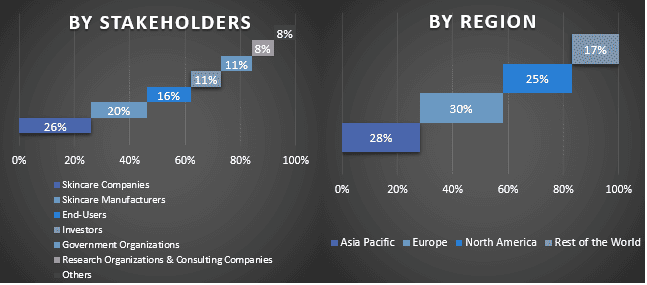
시장 공학
전반적인 시장 추정을 완료하고 글로벌 화학적 박피 시장의 각 세그먼트 및 하위 세그먼트에 대한 정확한 통계 수치에 도달하기 위해 데이터 삼각 측량 기술이 사용되었습니다. 데이터는 글로벌 화학적 박피 시장의 유형, 적용, 제품 및 지역 분야의 다양한 매개변수 및 트렌드를 연구한 후 여러 세그먼트 및 하위 세그먼트로 분할되었습니다.
글로벌 화학적 박피 시장 연구의 주요 목적
글로벌 화학적 박피 시장의 현재 및 미래 시장 동향이 연구에서 지적되었습니다. 투자자는 연구에서 수행된 질적 및 양적 분석에 대한 투자를 위한 재량을 기반으로 전략적 통찰력을 얻을 수 있습니다. 현재 및 미래 시장 동향은 지역 수준에서 시장의 전반적인 매력을 결정하여 산업 참여자가 미개척 시장을 활용하여 선점 우위를 누릴 수 있는 플랫폼을 제공합니다. 연구의 다른 양적 목표는 다음과 같습니다:
- 가치(USD) 측면에서 화학적 박피 시장의 현재 및 예측 시장 규모를 분석합니다. 또한 다양한 세그먼트 및 하위 세그먼트의 현재 및 예측 시장 규모를 분석합니다.
- 연구의 세그먼트에는 유형, 적용, 제품 및 지역 분야가 포함됩니다.
- 화학적 박피에 대한 규제 프레임워크의 정의 및 분석
- 다양한 중개인의 존재와 관련된 가치 사슬을 분석하고 업계의 고객 및 경쟁사 행동을 분석합니다.
- 주요 지역에 대한 화학적 박피 시장의 현재 및 예측 시장 규모를 분석합니다.
- 보고서에서 연구된 주요 지역 국가는 아시아 태평양, 유럽, 북미 및 기타 지역을 포함합니다.
- 화학적 박피 시장의 회사 프로필 및 빠르게 성장하는 시장에서 지속하기 위해 시장 참여자가 채택한 성장 전략.
- 업계의 심층 지역별 분석
자주 묻는 질문 자주 묻는 질문
Q1: 화학적 필 시장의 현재 시장 규모와 성장 잠재력은 무엇인가?
Q2: 화학적 필 시장 성장의 동인은 무엇인가?
Q3: 유형별 화학적 필 시장에서 가장 큰 점유율을 차지하는 부문은?
Q4: 화학적 필 시장의 새로운 기술과 트렌드는 무엇인가?
Q5: 어떤 지역이 화학적 필 시장을 지배할 것인가?
관련 보고서
이 상품을 구매한 고객님들도 함께 구매하신 상품










